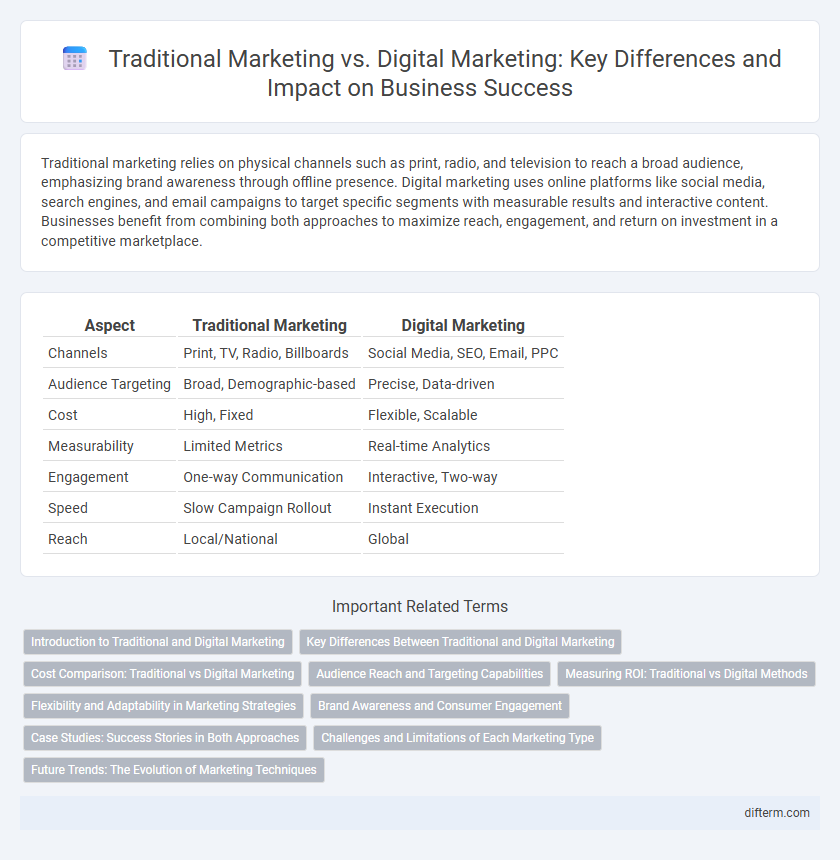Traditional marketing relies on physical channels such as print, radio, and television to reach a broad audience, emphasizing brand awareness through offline presence. Digital marketing uses online platforms like social media, search engines, and email campaigns to target specific segments with measurable results and interactive content. Businesses benefit from combining both approaches to maximize reach, engagement, and return on investment in a competitive marketplace.
Table of Comparison
| Aspect | Traditional Marketing | Digital Marketing |
|---|---|---|
| Channels | Print, TV, Radio, Billboards | Social Media, SEO, Email, PPC |
| Audience Targeting | Broad, Demographic-based | Precise, Data-driven |
| Cost | High, Fixed | Flexible, Scalable |
| Measurability | Limited Metrics | Real-time Analytics |
| Engagement | One-way Communication | Interactive, Two-way |
| Speed | Slow Campaign Rollout | Instant Execution |
| Reach | Local/National | Global |
Introduction to Traditional and Digital Marketing
Traditional marketing utilizes conventional channels such as print media, television, radio, and direct mail to reach broad audiences through physical and offline methods. Digital marketing leverages online platforms including social media, search engines, email, and websites to target specific consumer segments with measurable and interactive campaigns. Both marketing types serve strategic roles in brand promotion, customer engagement, and sales growth within diverse market environments.
Key Differences Between Traditional and Digital Marketing
Traditional marketing relies on physical channels such as print, television, and radio to reach broad audiences, while digital marketing utilizes online platforms including social media, search engines, and email for targeted outreach. Traditional marketing often involves higher costs and limited measurement capabilities, whereas digital marketing provides real-time analytics and cost-effective strategies tailored to specific demographics. The key difference lies in engagement methods: traditional approaches focus on mass communication, whereas digital marketing enables personalized interactions and data-driven decision-making.
Cost Comparison: Traditional vs Digital Marketing
Traditional marketing typically incurs higher costs due to expenses related to print ads, TV commercials, and physical promotional materials, often requiring larger budgets for broad reach. Digital marketing offers cost-effective alternatives such as pay-per-click campaigns, social media advertising, and email marketing, enabling precise targeting and real-time budget adjustments. Businesses can achieve a higher return on investment (ROI) with digital strategies by minimizing waste and focusing spend on engaged audiences.
Audience Reach and Targeting Capabilities
Traditional marketing relies on broad audience reach through mediums like TV, radio, and print, targeting demographics based on geographic and basic psychographic data. Digital marketing offers precise targeting capabilities using data analytics, enabling personalized campaigns across channels such as social media, email, and search engines. Businesses can optimize ROI by leveraging digital platforms for granular audience segmentation and real-time engagement tracking.
Measuring ROI: Traditional vs Digital Methods
Measuring ROI in traditional marketing often relies on indirect metrics such as brand awareness surveys and estimated reach, making precise attribution challenging. Digital marketing enables real-time tracking through tools like Google Analytics and conversion pixels, providing granular data on user behavior and campaign effectiveness. This measurable transparency allows businesses to optimize budgets efficiently and achieve higher ROI compared to traditional methods.
Flexibility and Adaptability in Marketing Strategies
Traditional marketing relies on fixed campaigns with limited flexibility, often requiring substantial lead time for adjustments, whereas digital marketing enables real-time modifications based on immediate consumer feedback and data analytics. Digital platforms provide dynamic targeting options, allowing businesses to swiftly adapt strategies to evolving market trends and audience behaviors. Enhanced adaptability in digital marketing drives higher engagement and optimized return on investment compared to conventional marketing methods.
Brand Awareness and Consumer Engagement
Traditional marketing leverages print media, television, and radio to build brand awareness through broad audience reach and consistent messaging; however, it often lacks precise targeting and measurable consumer engagement metrics. Digital marketing utilizes social media platforms, search engines, and email campaigns to enhance brand awareness with targeted ads and real-time analytics, enabling personalized interactions and higher consumer engagement rates. Campaigns integrating SEO, content marketing, and influencer partnerships demonstrate significant improvements in brand visibility and customer loyalty compared to traditional methods.
Case Studies: Success Stories in Both Approaches
Case studies reveal that traditional marketing campaigns, such as Coca-Cola's "Share a Coke" initiative, achieved significant brand engagement through personalized packaging and mass media channels, resulting in a 7% sales increase. Digital marketing success stories include Dollar Shave Club, which leveraged viral videos and targeted social media ads to rapidly grow its subscriber base and disrupt the razor market. Both approaches demonstrate measurable ROI, with traditional marketing excelling in broad brand awareness, while digital marketing provides precise audience targeting and real-time analytics for optimization.
Challenges and Limitations of Each Marketing Type
Traditional marketing faces challenges such as high costs for print, TV, and radio advertising, limited targeting capabilities, and difficulties in measuring campaign effectiveness. Digital marketing struggles with issues like ad fraud, evolving algorithms that impact organic reach, data privacy regulations, and the need for continuous content creation to engage audiences. Both approaches require strategic integration to balance broad reach and precise targeting while managing budget constraints and performance tracking.
Future Trends: The Evolution of Marketing Techniques
Traditional marketing relies heavily on print media, television, and radio to reach broad audiences, but future trends indicate a significant shift towards personalized, data-driven digital marketing strategies. Emerging technologies such as artificial intelligence, augmented reality, and blockchain are revolutionizing customer engagement and measurement of marketing ROI. Businesses leveraging omnichannel marketing and real-time analytics are poised to outperform competitors by delivering hyper-targeted content and seamless customer experiences.
Traditional Marketing vs Digital Marketing Infographic

 difterm.com
difterm.com